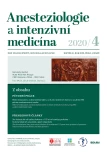Hypoxia and hypercapnia – how do the chemoreceptors work?
Authors:
D. Astapenko 1,2; V.- Černý 1 6
Authors‘ workplace:
Klinika anesteziologie, resuscitace a intenzivní medicíny, Fakultní nemocnice Hradec Králové
1; Lékařská fakulta v Hradci Králové, Univerzita Karlova
2; Centrum pro výzkum a vývoj, Fakultní nemocnice Hradec Králové
3; Klinika anesteziologie, perioperační a intenzivní medicíny, Univerzita J. E. Purkyně v Ústí nad Labem, Masarykova nemocnice v Ústí nad Labem
4; Department of Anesthesia, Pain Management and Perioperative Medicine, Dalhousie University, Halifax, Nova Scotia, Canada
5; Technická univerzita Liberec
6
Published in:
Anest. intenziv. Med., 31, 2020, č. 4, s. 195-197
Category:
Clinical Physiology
Overview
Proper oxygen and carbon dioxide tension is one of the basic prerequisites for maintaining homeostasis. In the context of the macroorganism, mechanisms have been developed that allow both acute and long-term responses to respiratory gas imbalances. Acute reactions are mediated by chemoreceptors (glomus caroticum, large vessel receptor zones, and chemo receptor centers in the brain) and primarily affect the respiratory pattern. Chemoreceptors work by transducing a chemical signal into an electrical one. Its genesis proceeds in several pathways, which lead to the closure of the potassium channel, the opening of the calcium channel and subsequently to the depolarization of the membrane. Long-term stimulation by hypoxia or hypercapnia leads to a response at the cellular level by altering transcription and gene expression. So far, the most studied is the so-called HIF pathway (hypoxia induced factor), the modulation of which in the experiment led to the mitigation of the effects of ischemia-reperfusion injury.
Keywords:
Hypoxia – hypercapnia – chemoreceptors – hypoxia induced factor
Sources
1. Cummins EP, Strowitzki MJ, Taylor CT. Mechanisms and consequences of oxygen and carbon dioxide sensing in mammals. Physiol Rev American Physiological Society 2020; 100(1): 463–488.
2. Kumar P, Prabhakar NR. Peripheral chemoreceptors: Function and plasticity of the carotid body. Compr Physiol NIH Public Access 2012; 2(1): 141–219.
3. Ma D, Liu M, Yang H, Ma X, Zhang Ch. Diagnosis and surgical treatment of carotid body tumor: A report of 18 cases. J Cardiovasc Dis Res Medknow Publications 2010; 1(3): 122–124.
4. Prabhakar NR, Semenza GL. Oxygen Sensing and Homeostasis. Physiology (Bethesda). 2015; 30(5): 340–348.
5. Taugher RJ, Lu Y, Wang Y, Creple CJ, Ghobbeh A, Fan R, et al. The bed nucleus of the stria terminalis is critical for anxiety‑related behavior evoked by CO2 and acidosis. J Neurosci Society for Neuroscience 2014; 34(31): 10247–10255.
6. Mulkey DK, Stornetta RL, Weston MC, Simmons JR, Parker A, Bayliss DA, et al. Respiratory control by ventral surface chemoreceptor neurons in rats. Nat Neurosci Nature Publishing Group 2004; 7(12): 1360–1369.
7. Xu F, Frazier DT. Role of the cerebellar deep nuclei in respiratory modulation. Cerebellum. 2002; 1(1): 35–40.
8. Gourine AV, Kasymov V, Marina N, Tang F, Figueiredo MF, Lane S, et al. Astrocytes control breathing through pH‑dependent release of ATP. Science 2010; 329(5991): 571–575.
9. Blain GM, Smith CA, Henderson KS, Dempsey JA. Peripheral chemoreceptors determine the respiratory sensitivity of central chemoreceptors to CO2. J Physiol J Physiol 2010; 588(13): 2455–2471.
10. Adluri RS, Thirunavukkarasu M, Dunna NR, Zhan J, Oriowo B, Takeda K, et al. Disruption of hypoxia‑inducible transcription factor‑prolyl hydroxylase domain-1 (PHD-1 -/-) Attenuates ex vivo myocardial ischemia/reperfusion injury through hypoxia‑ inducible factor- -1α transcription factor and its target genes in mice. Antioxidants Redox Signal Antioxid Redox Signal 2011; 15(7): 1789–1797.
11. Oriowo B, Thirunavukkarasu M, Selvaraju V, Adluri RS, Zhan L, Takeda K, et al. Targeted Gene Deletion of Prolyl Hydroxylase Domain Protein 3 Triggers Angiogenesis and Preserves Cardiac Function by Stabilizing Hypoxia Inducible Factor 1 Alpha Following Myocardial Infarction. Curr Pharm Des Bentham Science Publishers Ltd. 2014; 20(9): 1305–1310.
12. Quaegebeur A, Segura I, Schmieder R, Verdegem D, Decimo I, Bifari F, et al. Deletion or inhibition of the oxygen sensor PHD1 protects against ischemic stroke via reprogramming of neuronal metabolism. Cell Metab Cell Press 2016; 23(2): 280–291.
13. Schneider M, Van Geyte K, Fraisl P, Kiss J, Aragones J, Mazzone M, et al. Loss or Silencing of the PHD1 Prolyl Hydroxylase Protects Livers of Mice Against Ischemia/Reperfusion Injury. Gastroenterology W.B. Saunders 2010; 138(3).
Labels
Anaesthesiology, Resuscitation and Inten Intensive Care MedicineArticle was published in
Anaesthesiology and Intensive Care Medicine

2020 Issue 4
Most read in this issue
- Tranexamová kyselina
- Hypoxia and hypercapnia – how do the chemoreceptors work?
- Audit of antibiotic prophylaxis in surgery
- Insulin resistance, hyperglycemia and protein catabolism in the critically ill: looking for keys of the locked door
